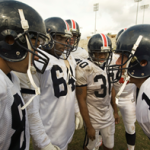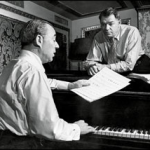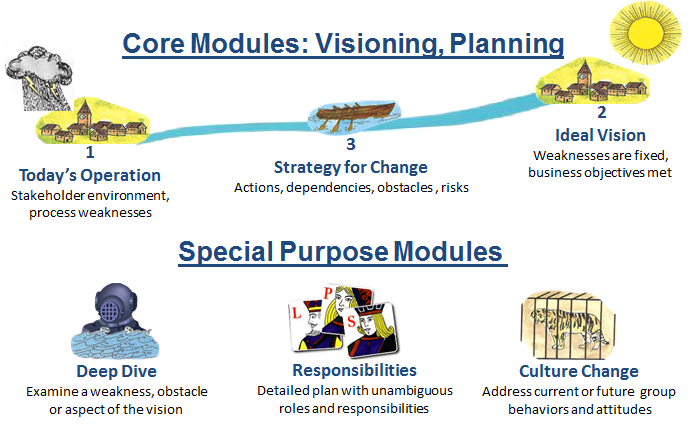Metaphor Mapping – a fast, fun way to align your team
Users build maps of their environment, processes and plans using sticker symbols. A village and its components are a process, where buildings are work centers, roads show relationships and flows. A river represents a plan. Goals, activities and obstacles are shown symbolically along the river bank. The symbols ensure good communication, facilitate discussion of difficult topics, ensure systems thinking and creative visioning.
How Metaphor Mapping helps teams align themselves
1. All Team Members Contribute
Metaphor Mapping was designed to make “big tent” groups effective. In Mapping workshops, there are no leaders or bosses. Everyone contributes based on their knowledge and ideas. The map-building process gently reinforces this at many points.
2. The Team Agrees its Goals
Following an introduction, workshops typically start with analysis of the current state of an operation. After the environment, structure and problems have been agreed, the group defines an ideal state where current problems have been resolved and their objectives are being met. Tools include a Village Map to define the process and a Zoo Map to define the attitudes and behaviors needed for success.
3. The Team Agrees and Executes a Plan
The team then defines how they will move from the current to the ideal state. Visual tools include a River Map to define the strategy, a Deep Dive Map to go into detail on critical points and a Facecards Map to define roles and responsibilities.
The workshop process and serious-play stickers ensure focus. high energy and ownership of results.
Teamwork, Collaboration and the skills needed
A team is a group of people who work together to achieve a goal. Think your division’s marketing team or– a sports team. A captain and many coaches calling the plays and telling you how to work better together.
 A collaboration is when two or more individuals or groups work together to achieve a goal, with nobody being the formal leader. This is often the case when working in “partnership” across organizations or companies. There may be nobody to make decisions or resolve differences. That’d be like the marketing groups from two divisions planning a promotion to a big client—or, a composer and lyricist working writing a song. Lot’s of tough and creative work to do, and it’s up to you to sort out how to work together to make a hit record.
A collaboration is when two or more individuals or groups work together to achieve a goal, with nobody being the formal leader. This is often the case when working in “partnership” across organizations or companies. There may be nobody to make decisions or resolve differences. That’d be like the marketing groups from two divisions planning a promotion to a big client—or, a composer and lyricist working writing a song. Lot’s of tough and creative work to do, and it’s up to you to sort out how to work together to make a hit record.
 All the skills needed for successful teams are needed for successful collaboration, but, collaboration’s bar is higher because there’s no oversight. Success depends entirely on the will and skill of the participants. If they’re not happy, they can reduce or stop their involvement using excuses such as “other priorities” just by not showing up.
All the skills needed for successful teams are needed for successful collaboration, but, collaboration’s bar is higher because there’s no oversight. Success depends entirely on the will and skill of the participants. If they’re not happy, they can reduce or stop their involvement using excuses such as “other priorities” just by not showing up.
- Collaboration is voluntary, at least to a degree.
- Lack of mutual respect and trust is poison.
- A process of interaction, setting priorities and decision making must be agreed
- A vision and strategy must be arrived at by consensus
- Roles must be agreed but changeable based on circumstance
Collaboration of diverse groups can generate novel solutions to client problems and new product and service ideas. Increasing need for speed, flexibility and change mean collaboration skill will become a differentiator. Organizations that rely on formal leaders to drive innovation will not be able to compete.

